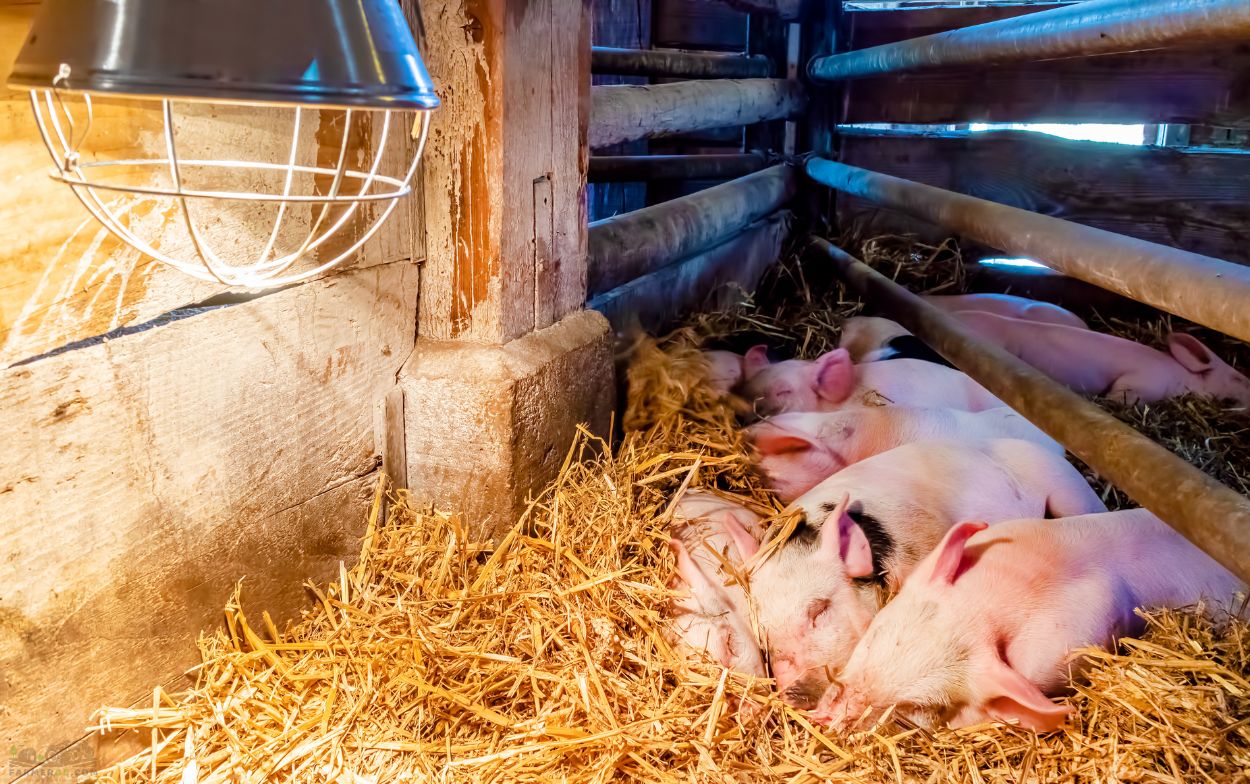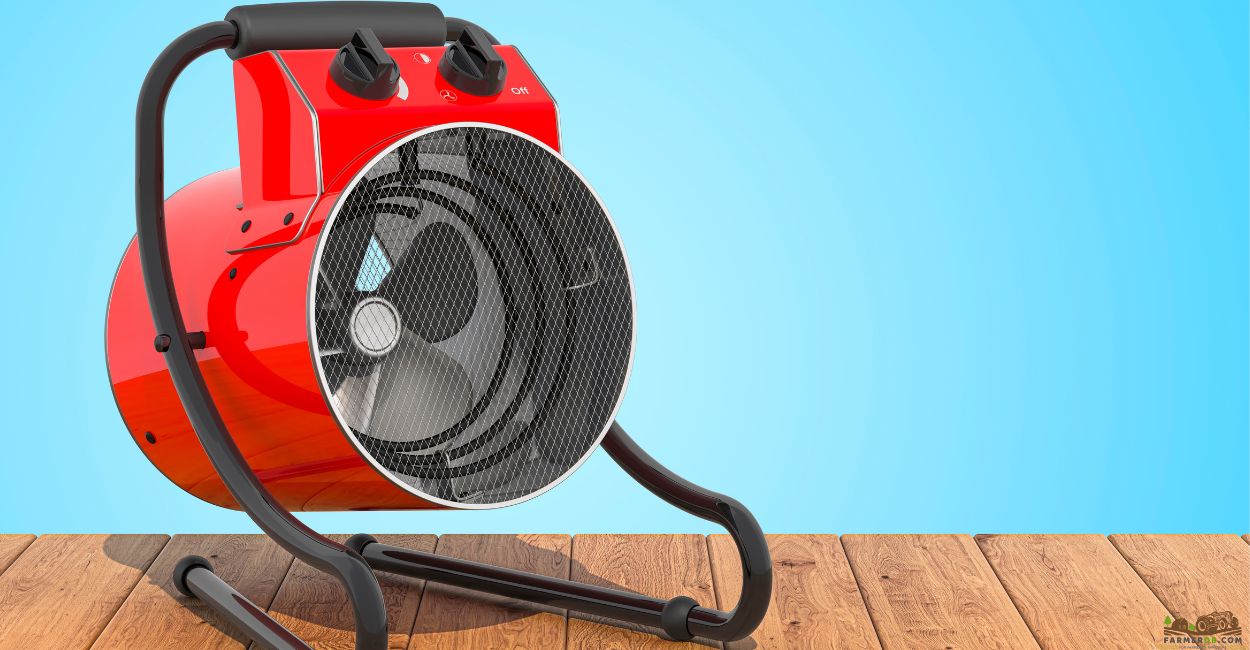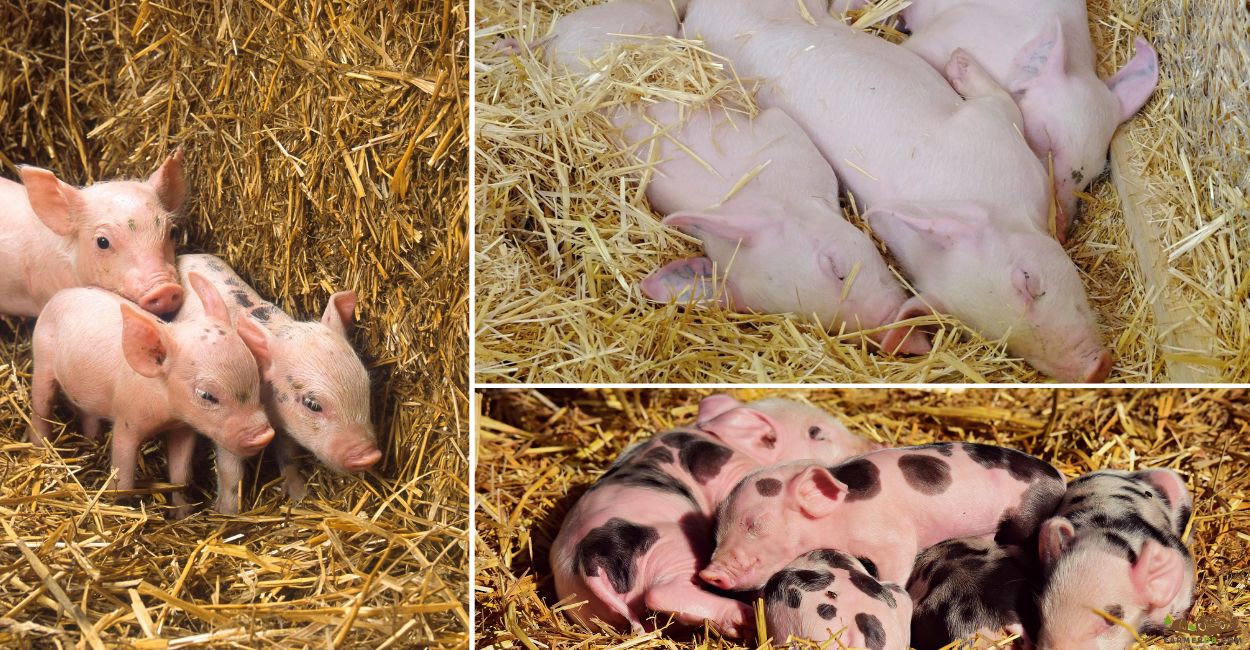
If you are a pig breeder who owns a farm or raises pigs on a homestead, your top priority should be to keep the piglet mortality rate as low as possible, or even eliminate it completely.
No matter what type of piglets you have, achieving this depends on how you heat and control the temperature of the piglets right after they are born.
While you can also later learn about piglet vaccines and common mistakes made by new pig owners, the temperature and heating during the first few hours of life are the most crucial factors in reducing piglet deaths.
By reading the following lines, you will discover the information you need. I will present it in a simple manner, which will save you time. This includes managing the temperature and heating for piglets, the essential equipment needed for heating piglets, the normal body temperature for piglets, effective temperature monitoring, and preparing for their birth.
Contents
Body Temperature in Piglets at Birth

The body temperature of piglets at birth is 101-103°F (38-39°C).
This temperature is similar to the temperature in the sow’s uterus. Still, the piglets’ body temperature changes quite rapidly after birth, as they are not able to maintain it.
The main reason for this rapid change is that piglets are born wet and immediately come into contact with the lower environmental temperature of the nursery area.
The temperature of the nursery directly affects the fluctuation of the piglets’ body temperature, causing rapid changes within minutes of birth.
Newborn piglets cannot regulate their body temperature, especially not immediately or within minutes after birth because their small bodies are not made for this.
Things to know: They are born with a small quantity of stored energy and body fat at birth. The energy in piglets is stored as glycogen in their muscles and liver. This stored energy’s primary purpose is not to regulate body temperature but to allow the piglets to reach the sow’s teats, feed, and ingest colostrum in order to start to develop and grow.
If piglets would have to regulate their body temperature because the nursery area temperature is not suitable, they would consume their stored energy, leaving them unable to feed. They would become apathetic and even die.
According to studies, the birth weight of piglets is also closely related to their body temperature. Piglets weighing less than 2.2 lbs have an increased risk of hypothermia because they have even less stored energy and fat at birth. This small amount of energy makes it harder for them to regulate their body temperature and feed from the sow’s teats.
Without the right conditions, their body temperature can drop drastically within the first 30 minutes after birth to around 96°F (35.5°C).
Everything below 96°F (35.5°C) is considered a lower critical temperature for newborn piglets.
Piglets need Temperature and Heating Management

One of the most common questions when breeding pigs throughout the year or in colder environments is whether piglets need heat.
The answer is simple: Yes, piglets do need heat in winter and colder weather conditions.
To minimize piglet mortality, it is important to prepare the nursery area temperature before the arrival of piglets.
And not only that. You have to make sure that the sow is comfortable alongside the piglets, as they have different needs when it comes to body temperature.
The nursery temperature should be prepared three days in advance of the expected birth. The nursery area should have a temperature of 72°F (22°C) three days prior to birth. The temperature of 72°F (22°C) must be kept constant until four days after the birth of the piglets. On the fifth day after birth, you can start decreasing it to 71°F (21.5°C), and gradually lower it by 1°F each day. On the eighth day after birth, the temperature can be decreased to 68°F (20°C).
Below in Table 1, you will find how to adjust the nursery room temperature management before and after the birth of the piglets.
| Days | Nursery room temperature |
|---|---|
| -3 | 72°F (22°C) |
| -2 | 72°F (22°C) |
| -1 | 72°F (22°C) |
| 0 | 72°F (22°C) |
| 1 | 72°F (22°C) |
| 2 | 72°F (22°C) |
| 3 | 72°F (22°C) |
| 4 | 72°F (22°C) |
| 5 | 71°F (21.5°C) |
| 6 | 70°F (21°C) |
| 7 | 69°F (20.5°C) |
| 8 | 68°F (20°C) |
| 9 | 68°F (20°C) |
| 10 | 67°F (19.5°C) |
Maintaining these temperatures allows you to provide newborn piglets with the ambient temperature they need while making sure that the sow remains comfortable.
If the temperature is higher than 75°F (23.5°C), it can cause stress to the sow, making her weaker and unable to provide the necessary amount of milk to the piglets. Therefore, it’s crucial to not forget about the sow’s health during the process of heating management for piglets.
Piglets are also just fine and can tolerate greatly a nursery room temperature of 72°F (22°C), but their body temperature must be kept above 96°F (35.5°C), which can not be done entirely only by keeping the room temperature.
Therefore, they need supplemental heat that can be provided by different tools like heat maps and lamps in a specific part of the nursery.
How long do piglets need heat lamps, maps, and temperature control?
Ideally, you should continue using heat lamps, mats, and temperature control for the first three weeks of the piglets’ lives. In winter and colder conditions, you can add five more days.
By the age of three weeks, the piglets can regulate their own body temperature and become comfortable at lower temperatures around 73°F (22.5°C) to 75°F (23.5°C) instead of 90°F (32°C) to 95°F (35°C) generated by the heating tools. At that point, you can turn them off.
When discussing outside temperatures, you should know that the piglets cannot be outside unless the weather is warm enough.
If the environmental temperature falls below 70°F (21°C), piglets can start to die within the first hour after birth, and even within minutes if it drops below 32°F (0°C).
Piglets Heating Equipment
There are specialized heating equipment options available that help achieve and maintain the nursery temperature. Furthermore, there are other specific equipment types designed to provide a safe temperature above 90°F (32°C) specifically for the piglets.
Heat Equipment for piglets
Heat Lamps

Heat lamps are one of the most common and traditional methods used to provide heat for newborn piglets. They generate warmth from top to down by utilizing a light bulb that emits infrared heat specifically for the piglets.
Heat lamps are designed with a reflector or a dome-shaped cover made of metal or ceramic, which directs the heat toward a specific area.
These lamps can be suspended directly above the piglets in any desired location within the nursery, ensuring that they remain warm and cozy.
Heating Mats or Pads

Heat mats and pads are heat sources that generate heat from the bottom and direct it upward. Typically, these mats and pads are positioned on the floor directly under the piglets’ bedding.
They have a layer of insulation to minimize heat loss and work by being connected to a power source.
Heat mats and pads are equipped with thermostats, which offer built-in temperature control. This provides consistent temperature regulation, creating a stable environment for the piglets.
This type of heat source for piglets provides a warm area on the floor where they can comfortably lie to keep themselves warm.
Gas-fired brooder
A gas-fired brooder is an efficient option that can be used to heat the piglet nursery. While typically used in poultry farms, it also works well in pig farms. This heating device utilizes natural gas or propane as a fuel source, generating a substantial amount of heat to warm the nursery.
Gas-fired brooders are known for their quick and even heat distribution. However, it is essential to position them correctly to ensure that the sow or piglets do not come into contact with the hot surface area.
Radiant tubes
Radiant tubes can be installed directly in the area where the piglets stay. These tubes provide localized heating only without heating other parts of the nursery.
Typically, they are installed above the piglets and suspended near the ceiling. One advantage is that they allow for heating multiple pens simultaneously through proper angle adjustment during installation.
To make a quicker decision, you can find the pros and cons for all the possible heat equipment for piglets in Table 2.
| Heat Lamps | Heating Mats or Pads | Gas-fired brooder | Radiant tubes |
|---|---|---|---|
| Pros: – It is easy to install. – It is easy to move around and adjust. – It generates a concentrated amount of heat. – It is widely available. |
Pros: – It provides heat to a larger area. – The heat is consistent on the entire surface from bottom to upwards. – It is safe for piglets that lie down on it. – The built-in thermostats allow you to easily control the temperature. – It consumes less electricity compared to heat lamps. – The heat does not radiate to bother the sow. |
Pros: – It can cover a very large area. – It provides a good and constant amount of heat. – It directly heats the surface without heating the air from the room. – It can be used in multiple pens at once. |
Pros: – It produces a substantial amount of heat. – Its stainless steel design makes it easy to clean. – It is highly durable. |
| Cons: – The light bulb does not last long and needs replacement often. – The light bulb can stop working, which can cause the death of piglets. – It can burn the piglets if positioned too low. – The bulb can break and cause a fire hazard or electrical shock danger. – It provides heat only to a small area. |
Cons: – It must be positioned in a location accessible to piglets. – It is more expensive. – It may require additional electrical outlets or wiring. |
Cons: – The surface gets very hot and can cause burns upon contact. – It requires regular and thorough cleaning to prevent excess carbon monoxide. |
Cons: – It is more expensive than other options. – It is harder to install. – It has limited ceiling height for mounting |
Heat Equipment for the nursery area
To ensure that the entire nursery area has a good temperature for sow and piglets you can use the following:
Forced-air heater

A forced-air heater is a heating system that evenly distributes warmed air throughout a nursery using a fan or blower. It has a high capacity for heating larger spaces and provides a quick solution to rapidly heat an entire area evenly.
It also incorporates a thermostat that allows you to adjust the temperature according to your needs. Depending on its type, it can be powered by natural gas, electricity, or oil.
Tip 1: I suggest installing a room thermometer in the nursery room or area. This way, you can easily monitor the temperature at a glance and ensure it remains within the desired range.
Tip 2: Ensure that the nursery area is also well-ventilated.
Additional Tips
In addition to heating systems and tools, you can use other simple methods to ensure the comfort of your newborn piglets.
Bedding

You can create a bedding of straw around the sow. After giving birth, the sow can use the straw to cover the piglets, keeping them warm. It is a natural instinct for the sow to provide warmth to her piglets just before giving birth.
All you need to do is purchase enough straw and lay it around the area. It’s an easy solution!
Drying the piglets
Piglets are born wet, so to ensure that their body temperature does not drop too low, you can use various techniques such as drying them with paper towels, cloth, straw, or powdered desiccants.
The technique of drying piglets doesn’t directly impact piglet mortality, as this is more closely related to birth weight. But, it does help maintain a more stable body temperature for piglets immediately after birth compared to non-dried piglets. This method is very beneficial for low birth weight piglets, as shown by studies.
Gently handle the piglets when drying them, using patting motions to absorb moisture from their small bodies. Avoid stressing them further by touching them gently.
Pay particular attention to drying their head, back, and abdomen as these areas tend to retain more moisture. Once dried, place them near the sow or under a heat lamp or another heat source.
Insulate the nursery
If you have a nursery housing for sows and piglets, especially in colder areas, I would recommend insulating it very well. Proper insulation in the nursery creates a warm environment for piglets and helps retain heat within the space for a longer period.
This not only ensures the comfort of the piglets but also reduces heating expenses.
Insulation materials like foam, fiberglass, or reflective barriers can be used to insulate the walls, ceilings, and floors, effectively minimizing heat transfer and maintaining a stable temperature within the nursery housing.
Checking piglets’ body temperature
To check the body temperature of piglets, you can use a digital rectal thermometer, which provides an accurate reading of their internal temperature.
Here are the steps to follow:
- Have a clean and sanitized digital rectal thermometer ready beside you.
- Approach the piglet gently. If the piglet is stressed, gently restrain it. Ensure you do not cause any discomfort.
- Apply a small amount of water-based lubricant to the thermometer.
- Insert the thermometer gently into the piglet’s rectum but not more than 0.7 inches in depth.
- Leave the thermometer in the rectum for a few seconds, or until it indicates the measurement is complete (some thermometers beep when finished).
- Read the temperature displayed on the thermometer and carefully remove it from the piglet’s rectum.
- Safely and gently lay the piglet down again.
- Interpret the temperature reading. The average body temperature of a piglet ranges between 102°F (38.5°C) to 103.5°F (39.5°C). It is considered critical if the temperature drops below 96°F (35.5°C). If the temperature is within the normal range, the piglet is in good health. If it approaches the critical temperature, take immediate action.
- Remember to clean the thermometer thoroughly to prevent the potential spread of diseases.
What to do when the piglet has a low body temperature
When a piglet has a low body temperature, typically around or below 96°F (35.5°C), immediate action is crucial to prevent piglet hypothermia.
Here’s what you should do:
– Take the piglet and place it under a supplemental heat source such as a heat lamp, heating pad, or mat.
– At the same time, gently massage the piglet’s body, particularly the limbs and abdomen area. This massage helps improve blood circulation and heat distribution.
– Ensure the piglet eats enough milk. When body temperature drops, piglets may have difficulties competing at the sow’s udder. Help the piglet by providing access to colostrum and milk. Warm fluids raise the body temperature from within.
– Monitor the piglet, even after its temperature improves.
– Lastly, ensure the nursery is heated and the temperature is constant. Check the supplemental heat source for piglets, ensuring all piglets can reach and benefit from it. Also, make sure there is sufficient space for all piglets under or above the heated area.
Signs that can help you assess the pig’s temperature without a thermometer
You can determine whether piglets are cold or warm by observing their behavior.
Here are some signs to look out for:
– If the piglets feel chilly, you will notice their hair standing up or puffed up on their entire body.
– If the piglets are staying at a distance from each other under or on the supplemental heat source, it indicates that they are possibly even slightly warmer than necessary.
– If the piglets are sleeping on top of each other in a crowded manner, it indicates that they are cold and trying to keep warm. If you observe this behavior, it is important to check for any issues in the setup that may be causing insufficient warmth for the piglets.
– If they are side by side, they are at a comfortable temperature.
More useful tips
– Make sure that all piglets are well-fed. I would suggest keeping a close eye on the piglets with lower body weight and ensuring they consume sufficient colostrum. If they are unable to compete for a spot at the sow’s udder, help them. Feeding is essential for piglets to maintain their body temperature.
– Be careful when positioning the supplemental heat source for the piglets. First, ensure that the piglets can easily access the heat source to warm themselves. At the same time, make sure that the additional heat does not reach the sow, as you want to avoid overheating and causing stress to her.
– When positioning the lamp or mat, ensure that there is no risk of the sow accidentally rolling over and crushing her piglets.
– Always ensure that the heating source is functioning properly.
– Equip your nursery area with a good ventilation system, especially if the space is well sealed.


can use a blazer incase you don’t have a
light emitting bulbs